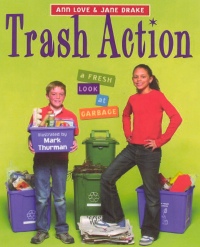| ________________
CM . . .
. Volume XII Number 13 . . . .March 3, 2006
excerpt:
The Canadian author team of Love and Drake continues their longstanding commitment to educating young readers about environmental issues with this highly readable book on ways to deal with garbage. An introduction invites readers to "re-think" their relationship with Nature, promising ways to help measure "how much Nature you use every day." The challenge is issued to help sustain the natural world by analyzing the size and impact of one's ecological footprint. The first chapter defines this footprint and suggests general ways to be a more responsible consumer. The terms reduce, refuse and reuse are discussed in the second section, with examples from history. Recycling merits its own chapter, with an overview of the types of programs in place across the country. If waste items cannot be recycled, the landfill or incineration answer is examined. A further chapter talks about the garbage that ends up as litter or is dumped, presumably out of sight (the far north, outer space, in the Great Lakes). Finally, the authors suggest how we can respect future generations by making wise choices as consumers. Cartoon characters, Rolly, Can-it and Bright Bulb, reinforce key themes throughout the book. For intermediate and young adult readers who have been raised on the concept that one can take action to be part of the solution to global garbage woes, this book will take that message one step farther. There's lots here for adults too. It is both informative and interactive. A fascinating examination of the stuff we use and discard is presented in the detailed factual accounts, through historical glimpses, and also through traditional storytelling, such as the Gitksan tale of avoiding wastefulness. Lists and graphics help walk the reader through the data that shows the extent of our wasteful consumer habits. Reader involvement is encouraged with a self survey, 10 questions that test attitudes about responsible purchasing with waste in mind and that propose some hard choices. Another activity asks readers to decide on the size of their ecological footprint based on various criteria. A multiple choice quiz helps readers figure out the environmental plus-minus score of things they might buy. This particular challenge might leave some readers scratching their heads over the need to decide if "certified forest practices were implemented or environmental safeguards used in extraction" of the raw materials used in manufacture. Highly motivated readers may be the primary audience for this book. It will be a valuable guide for initiating discussions, research and science projects for an environmental studies unit. For leisure reading, a wealth of intriguing facts await: did you know that the average Canadian household produces close to a ton of garbage in a year? That New Yorkers could save five million pounds of waste each year by using one less grocery bag each per week? That every ton of recycled paper saves 17 trees? Being a more enlightened consumer can have a huge impact on the Earth. Trash Action will leave its readers thinking, and re-thinking. Highly Recommended. Gillian Richardson, a freelance writer and former teacher-librarian, lives in BC.
To comment
on this title or this review, send mail to cm@umanitoba.ca.
Copyright © the Manitoba Library Association. Reproduction for personal
use is permitted only if this copyright notice is maintained. Any
other reproduction is prohibited without permission.
NEXT REVIEW |
TABLE OF CONTENTS FOR THIS ISSUE
- March 3, 2006.
AUTHORS |
TITLES |
MEDIA REVIEWS |
PROFILES |
BACK ISSUES |
SEARCH |
CMARCHIVE |
HOME |
